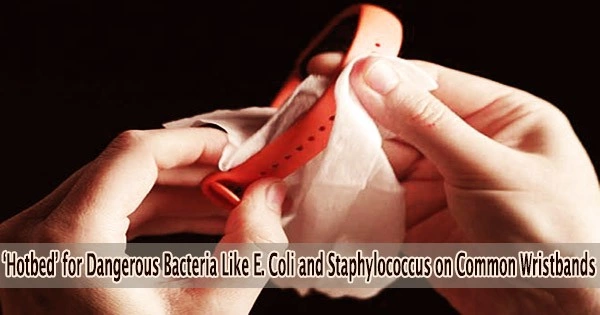The COVID-19 epidemic raised the bar for disinfection. Now, a recent study investigating a widely used item might persuade you to wait before lowering your guard.
Wristbands of various textures were evaluated by scientists from Florida Atlantic University’s Charles E. Schmidt College of Science to see how likely they were to contain potentially dangerous pathogenic bacteria. Even though wristbands are worn every day, routine cleaning is sometimes forgotten about or just disregarded.
In order to determine whether there is a relationship between wristband material and the presence of germs, researchers evaluated wristbands made of plastic, rubber, cloth, leather, and metal (gold and silver). They looked into the cleanliness of the numerous wristbands used by athletes and determined the most effective cleaning procedures.
Researchers examined bacterial numbers, types of bacteria, and dispersion on the wristband surfaces using common microbiological techniques. They also conducted a bacteria susceptibility assay study screening the effectiveness of three different disinfectant solutions: Lysol™ Disinfectant Spray; 70 percent ethanol, commonly used in hospitals and alcohol wipes; and a more natural solution, apple cider vinegar.
The study’s findings, which were published in the journal Advances in Infectious Diseases, opine that the next time you buy a wristband, you might want to “go for the gold” or “silver.” 95 percent of bracelets were infected. However, the bacterial counts on rubber and plastic wristbands were higher than those on metal ones, particularly silver and gold.
“Plastic and rubber wristbands may provide a more appropriate environment for bacterial growth as porous and static surfaces tend to attract and be colonized by bacteria,” said Nwadiuto Esiobu, Ph.D., senior author and a professor of biological sciences in the Charles E. Schmidt College of Science.
The quantity and taxonomy of bacteria we found on the wristbands show that there is a need for regular sanitation of these surfaces. Even at relatively low numbers these pathogens are of public health significance. Importantly, the ability of many of these bacteria to significantly affect the health of immunocompromised hosts indicates a special need for health care workers and others in hospital environments to regularly sanitize these surfaces.
Nwadiuto Esiobu
The texture of the wristband material and the subject’s activities (hygiene) at the time of sampling were the two most significant predictors of wristband bacteria load. The prevalence or distribution of the bacteria groups did not significantly differ between males and females.
Bacteria found in the study were common skin residents of the genera Staphylococcus and Pseudomonas, and intestinal organisms of the genera Escherichia, specifically E. coli. Staphylococcus spp was prevalent on 85 percent of the wristbands; researchers found Pseudomonas spp on 30 percent of the wristbands; and they found E. coli bacteria on 60 percent of the wristbands, which most commonly begins infection through fecal-oral transmission.
The fact that the gym-goer had the highest staphylococcal levels highlights the need to sanitize wristbands following strenuous exercise, whether it is at the gym or at home.
A form of bacteria called Staphylococcus aureus, which can be found on human skin, in the nose, armpit, groin, or other places, is responsible for a wide range of clinical disorders. Pseudomonas spp., commonly in the environment, can cause infections in the blood, lungs (pneumonia) or other parts of the body after surgery. Enterobacteria are a large family of bacteria including many of the more familiar pathogens such as E. coli and Salmonella.
“The quantity and taxonomy of bacteria we found on the wristbands show that there is a need for regular sanitation of these surfaces,” said Esiobu. “Even at relatively low numbers these pathogens are of public health significance. Importantly, the ability of many of these bacteria to significantly affect the health of immunocompromised hosts indicates a special need for health care workers and others in hospital environments to regularly sanitize these surfaces.”
Findings from the study showed that Lysol™ Disinfectant Spray and 70 percent ethanol were highly effective regardless of the wristband material with 99.99 percent kill rate within 30 seconds. Apple cider vinegar was not as potent and required a full two-minute exposure to reduce bacterial counts.
While these common household disinfectants all proved at least somewhat effective on all materials (rubber, plastic, cloth and metal), antibacterial efficacy was significantly increased at two minutes compared to thirty seconds.
Depending on the active chemicals in different disinfectants, bacteria can be killed in various ways, including by causing damage to cell membrane integrity, modifying or eliminating proteins, or interfering with metabolic processes.
“Other potential forms of bacterial transmission and facilitation of infection, such as earbuds or cell phones, should be similarly studied,” said Esiobu.
Study co-authors are Joseph Mendonca; Belen Wertheimer; Daynalee Dixon; Bodhi Stone; and Karim Dawkins, FAU undergraduate and graduate students within the Microbial Biotechnology Laboratory, Department of Biological Sciences, Charles E. Schmidt College of Science; and Miranda Christian, a former reporter in West Palm Beach.
















